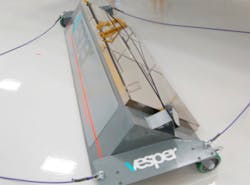Measurement system verifies spec of space sunshield
Engineers at Vesper have developed a non-contact system to verify the dimensional specifications of the five layered sunshield for NASA’s James Webb Space Telescope (JWST). The sunshield will allow the telescope to cool down to a temperature below 50 Kelvin by passively radiating its heat into space.
Awarded a contract in 2010, Vesper is performing shape and dimensional validation of the large membranes used in the sunshield that were fabricated by ManTech International Corporation (Huntsville, AL, USA) for Webb design and engineering contractor Northrop Grumman (Falls Church, VA, USA).
The five Webb sunshield layers, each the size of a tennis court, are made of specialized Kapton material, a very thin plastic with a reflective metallic coating. Once they are tensioned, the membranes are not flat, so their 3-D shape has to be measured carefully. The relative separations and alignments of each of the five membrane layers are a critical factor in achieving the desired cryogenic operating temperature of JWST's telescope and instruments.
According to Vesper CEO Eric Lundberg, it is particularly challenging to measure the mirrored surface of the sunshields with a non-contact system. To take the measurements, Vesper used a modified Metricvision/Metris MV260 non-contact laser radar optical measurement system and a custom mirror array.
Along with the ManTech engineering team, Vesper's team will use ther equipment to measure all five of the membranes to ensure that the sunshield system will perform as designed in orbit.
After all five layers of the full-size sunshield templates are completed and tested in Huntsville, they will be sent to Northrop Grumman Aerospace Systems (Redondo Beach, CA, USA) for final assembly and additional testing.
Related items from Vision Systems Design that you might also find of interest.
1. Telescope captures images of the Whirlpool galaxy
The Lowell Observatory has released the first images taken with a 4k x 4k imaging sensor from e2v (Chelmsford, UK) that equips its flagship Discovery Channel Telescope (DCT).
2. Telescope captures deepest space image on record
The European Southern Observatory’s (ESO; Garching, Germany) Vista telescope has created the widest deep view of the sky ever made using infrared light.
3. Infrared camera assembly completed for James Webb Space Telescope
Engineers at Lockheed Martin (Bethesda, MD, USA) have completed the assembly of the Near Infrared Camera (NIRCam), the prime near-infrared imaging instrument for NASA's James Webb Space Telescope (JWST).
4. Naval Research Lab imager heads for the sun
An optical telescope under development at the Naval Research Laboratory (NRL; Washington, DC, USA) is to be launched into space as part of the European Space Agency (ESA)’s Solar Orbiter mission to study our sun.
5. Image sensors to spot objects in the Kuiper Belt
Imaging sensor maker e2v (Chelmsford, UK) has been awarded a contract by the Academia Sinica Institute of Astronomy and Astrophysics (ASIAA) in Taiwan to supply a set of 40 large-area CMOS imaging sensors for three ground-based telescopes as part of the Transneptunian Automated Occultation Survey (TAOS II).
-- Dave Wilson, Senior Editor, Vision Systems Design
